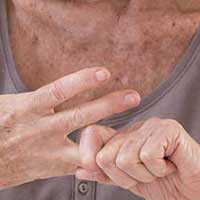What is arthritis?
The inflammation and the pain of joints that an individual suffers from is called arthritis. Arthritis is a commonly misunderstood term as many people think of it as a single type of disease. In reality, arthritis is an umbrella term that is used to refer to over 100 types of joints pains.
All these joint pains have their own set of symptoms and treatments. Arthritis is found in individuals who are over the age of 65 or are overweight. However, arthritis can also be found in children, teenagers, and young adults.
Arthritis is mainly a rheumatic condition that affects the joints, the tissues surrounding the joints, and all other connecting tissues.
What causes arthritis?
Our joints are protected by a connecting tissue known as the cartilage. This strong and flexible tissue protects our joints from damage. The cartilage absorbs the shock that we put on our joints when performing an activity.
If the cartilage tissue declines, it will start to cause arthritis. This is because cartilage will not be able to absorb the pressure. Hence, this would lead to deterioration of joints faster.
The natural deterioration of the cartilage tissue can cause osteoarthritis. Moreover, if you develop a tissue infection or tissue injury, the deterioration of the cartilage would be faster.
The immune system may attack the tissues in the body as well. This leads to a decline in synovium, which is a soft tissue found in the joints. With this decline, the cartilage also starts to deteriorate as synovium produces a fluid that is beneficial to the cartilage and strengthens the joints.
Types of arthritis
The types of arthritis can be classified as the following:
- Osteoarthritis
Osteoarthritis is caused when the cartilage starts to deteriorate. This leads to the bones grinding against each other, thus, causing pain. With the deterioration of the cartilage, the joints experience more pressure that a healthy cartilage would otherwise absorb.
Any injury to the tissues may also cause the cartilage to suffer. This particular form of arthritis is common in people who have a family history or have had ACL.
Osteoarthritis can lead up to become a chronic pain and is also often referred to as degenerative arthritis.
- Rheumatoid Arthritis
Rheumatoid Arthritis is known as inflammatory arthritis. When the immune system starts to affect the tissues negatively, rheumatoid arthritis starts to develop. There is a soft tissue in the joints that produces a certain liquid that keeps the joints healthy, but with tissue disintegration, this liquid is not produced in sufficient amounts, hence, causing RA.
- Infectious Arthritis
When bacteria enter the body, they cause an inflammation of the tissues and joints. This particular form of arthritis commonly develops as a result of food contamination, sexually transmitted diseases1, and hepatitis C.
- Metabolic Arthritis
Uric acid develops when our body breaks down purines which are a substance found in our cells and some forms of food. High levels of uric acid can form crystal needles in the joints which then cause joint pain or even gout attacks.
Signs and symptoms of arthritis
Although there are multiple types of arthritis, arthritis symptoms and signs are usually common for all forms in the beginning stages. If you notice any of the symptoms mentioned, immediately contact your doctor.
- Joint Pain and Swelling
These two are the most common symptoms of arthritis. Joint pain and swelling start to occur as soon as you start to develop arthritis. The severity of the pain and swelling will vary from person to person and on the type of arthritis that you have. These symptoms can be relieved by rest and aggravated by activity.
- Stiffness of Joints
Arthritis is always accompanied by stiffness of joints. The difference in joints can be found by comparing your stiffened joint with the same joint on the other side of your body. Generally, people with arthritis complain of a stiff joint in the morning or after sitting for long intervals.
- Joint Deformity
The wear and tear of the cartilage is a known cause of arthritis. Hence, with the cartilage deteriorating and nothing left to support and cushion the joints, the joints start to lose shape. The deformity of the joints due to arthritis may be seen in crooked fingers, as a knock-knee or in a bow-leg.
- Grinding
With the cartilage wearing out, nothing will be left to protect and cover the joints. This would leave the joints and bones exposed. When these exposed joints rub against one another, a “grinding sensation” may be experienced.
- Fluids
Pockets of lumps may be formed around the joint area if you have arthritis. They may be sensitive to touch.
Treatment for arthritis
Arthritis can be dealt with the following ways:
- Arthritis medication
Analgesics may be taken to lower the extent of pain. However, these medicines do not cater to inflammation. Examples include Tylenol.
Non-steroidal anti-inflammatory drugs can be bought online or at your local pharmacy. These medications are known to cater to both the pain and inflammation associated with arthritis. Examples include Advil.
There are various creams and lotions available that help reduce pain and inflammation. These can be purchased online or at the local pharmacy.
- Physical therapy
Try to engage in warm water exercises2. The water will hold your weight and allow easy exercise without putting pressure on the joints.
Your doctor may combine physical therapy with pain and inflammation-relieving medicines for an enhanced effect. This may involve doing small everyday chores and exercises like swimming, cycling, and walking.
- Weight loss
Obesity is one of the common causes of arthritis. Although there is no specific type of food that can treat arthritis, there are some that provide nourishment to the joints. These include:
- Fish
- Nuts
- Seeds
- Fruits
- Vegetables
- Beans
- Olive oil
- Whole grains
Then, there are some types of foods that should be avoided even within these nutritious foods.
- Fried/processed foods
- Alcohol
- Dairy
You can also self-manage arthritis through:
- Being active physically
- Being healthy
- Regular visits to the doctor for routine check-ups
- Managing pain
- Taking care of your joints
- Maintaining a healthy weight
- Taking care of your diet
- Keeping yourself organized
- Getting a good night’s sleep
- Careful maintenance of overall health
References:
- Medline Plus - Sexually Transmitted Diseases
- Heathline - Diving In: Water Exercises for Arthritis Relief

